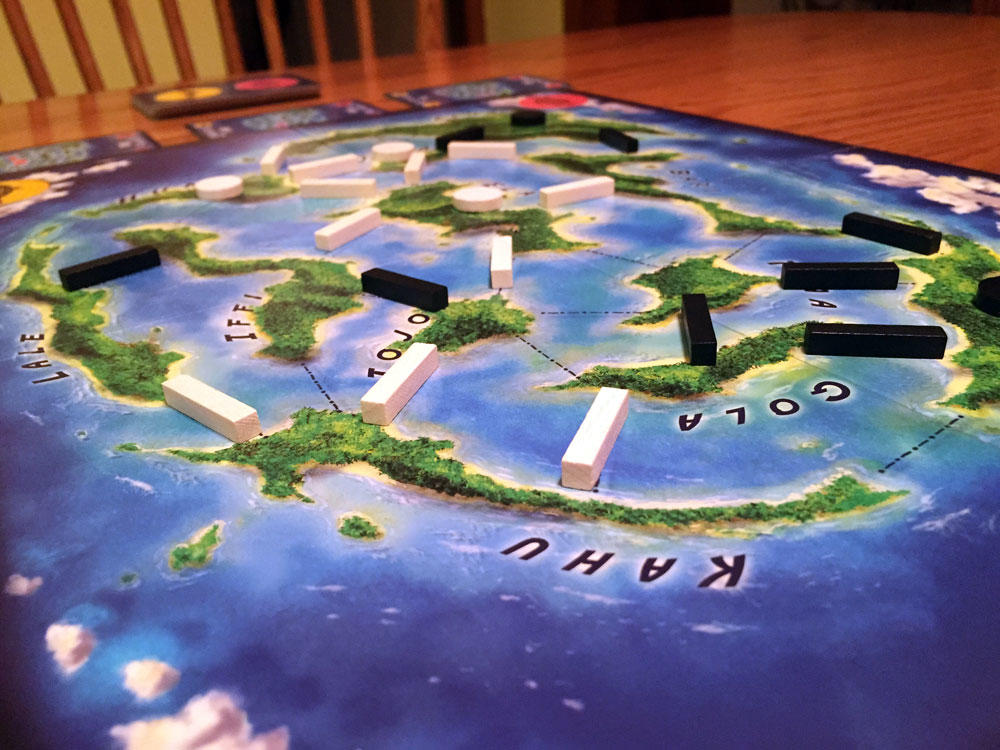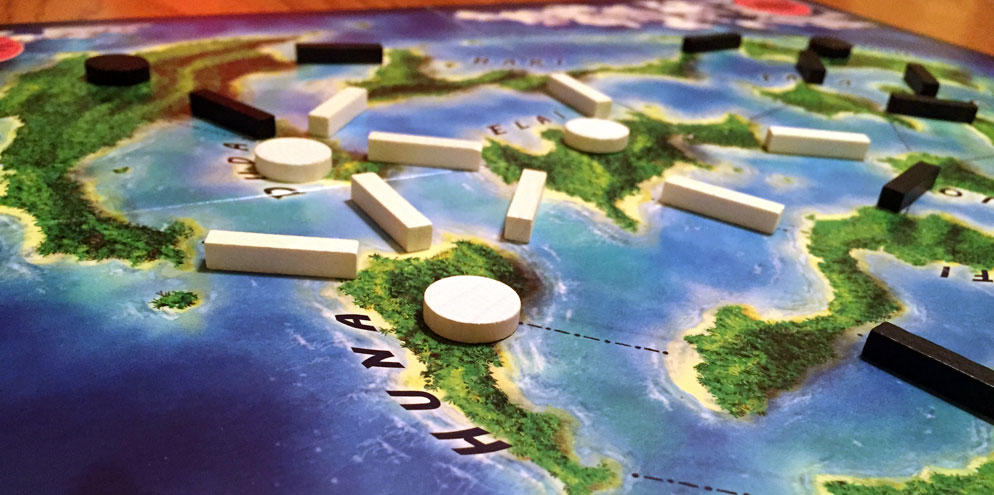 I love two-player games. The primary gamer in my life is my wife. Her gateway game was Lost Cities, a two-player game published by Kosmos. I taught her the game on a picnic bench in the Wisconsin Dells, Summer 2009 (I am a romantic, I know… “Hey baby, instead of a wild night partying in the Dells, how about we play this card game…” tldr: Taught a girl Lost Cities, she married me ASAP).
I love two-player games. The primary gamer in my life is my wife. Her gateway game was Lost Cities, a two-player game published by Kosmos. I taught her the game on a picnic bench in the Wisconsin Dells, Summer 2009 (I am a romantic, I know… “Hey baby, instead of a wild night partying in the Dells, how about we play this card game…” tldr: Taught a girl Lost Cities, she married me ASAP).
I was offered a chance to review Kahuna, another two-player game published by Kosmos, and I jumped at the opportunity. Who wouldn’t want to take on the role of one of two opposing “ancient sorcerers of the Pacific,” a.k.a. Kahunas? I am NOT making this up… it is on the back of the box.
Kahuna is an abstract game about building and destroying bridges in order to capture and hold the majority of islands in a fictional tropical setting. It is a two-player game only and can be played between 30 and 45 minutes – 30 if you are both gamers, 45 minutes if one of the two gamers playing happens to be my spouse.
Game Overview:
The object of the game is to control more islands than the Kahuna opposing you. This is done primarily by placing bridges for yourself to take over islands, or by decimating your opponent’s bridges, paving the way for your eventual conquest. The game consists of three scoring rounds. After the end of the third round, the player with the most points…
…hold your breath…
…is the winner. Shocking, I know.
Game Components:

The game is light on components, but this is to be expected, as it is a two-player Kosmos game. Kahuna includes 50 wooden bridge markers and 20 wooden Kahuna tokens (these mark which islands you currently control), divided evenly between being colored black or white. They are completely functional, but not mind-blowing. They are exactly like the fences and resource markers from Agricola.
The game board is compact and has a beautiful illustration of twelve fictional islands. Between the islands are dotted lines indicating where bridges can be placed. It also includes two yellow and two red circles at the edges of the board to indicate which side of the board you are sitting on.
These circles are an aid for the 24 island cards (two for each island) included in the game. Each card uses these same circles to indicate how to orient the card compared to the board so you can find the island you are seeking. Also included on the cards is an indicator of the number of bridges that are connected to that island.
And that is it for components. Oh, and a rulebook is included as well. While light on components, I did not consider this a detraction. The game has a small footprint and travels very well.
How to Play:

I usually do not provide a complete walk-through of how to play, rather I lazily efficiently provide you a link to the rulebook here . However, this game is simple enough that I can describe how to play in two paragraphs.
Each player begins with three island cards in his hand. The board is placed between both players and the top three cards are turned face-up next to the draw pile.
The first player may play as many island cards as he wants, or, alternatively, can choose to not play a card. When an island card is played individually, the player places one of his colored bridges on the dotted black line from that island to another island connected to it. If a player controls more than half of the bridges on an island, he places a round control marker on that island and removes any of his opponent’s bridges connected to the island.
The only time two cards are played simultaneously instead of being resolved individually is if the player plays two of the same bridge connection for a connection that is under his opponent’s control. When this happens, the opponent’s bridge is removed from the board. If this causes your opponent to drop below more than half of the bridges on an island that he controlled, his control marker would be removed as well.
At the end if his turn, the player may either draw one of the three face-up cards (immediately replacing the card with a new card from the draw pile), or he may take the facedown card directly from the draw pile. A player may also abstain from drawing a card, but this action is not allowed if his opponent abstained in the previous turn.
The round ends when the draw pile and all three face-up cards have been drawn. The player with the most connections at this time earns ONE point. Round two repeats the same as round one, except that the player with the most connections at this time earns TWO points. Scoring in the third round is the differential between the number of islands that are controlled. As previously stated, whoever has the most points wins the game. Ties are broken by whoever has the most bridges on the board at the end of the game.
OK, so I lied – that was more than two paragraphs. But now you really know how to play the game.
Note: there are two variants for the game:
- The draw pile is played face-up – we did NOT play any games this way and so my review does not cover this variant.
- Once you control an island, your opponent cannot build to your island until you no longer control the island – we mostly played using this variant. In the normal rules, after your opponent gains control of an island and removes any of your bridges from the island, you can immediately build bridges to that island, even though you do not control it.

Game Experience:
Please note, again, that we mostly played with the no bridges to controlled island variant – if you like more randomness, please play the game without any of the variants.
We enjoyed Kahuna. The game is simple and easy to teach, but the decisions are difficult. There are only two cards of every island in the game. That, combined with the hand limit of five cards, makes your decisions that much more difficult. Balancing between playing cards to place bridges one at a time vs. holding onto your cards and only drawing a card because you are waiting to drop three cards in a row to dominate your opponent, are what make this game enjoyable. If you REALLY want to destroy one of your opponent’s bridges, but you only have one of the two cards you need to do so, do you want to hold on to that card and hope you get the card you are looking for later in the round?

This provides a similar feeling to other two-player only games in which the draw pile is shared and the number of cards is limited (Battle Line and Lost Cities, for example, in which there is only one copy of every card in the game). You are waiting for the card(s) you need to appear, but your opponent has the same probability of drawing the card(s) as you do.
One potential issue with the game is that it is 100% tactical. You are limited to the three face-up cards and the top of the draw pile. Card draw (luck?) can have a significant impact on the game and does not allow room for long-term strategy.
Another potential issue is that players who have not played the game before will be at a significant disadvantage against players who have played before. My daughter, who is good at games, was trounced by me because she and I played after I had already played against my wife five or six times. My wife and I played extremely close games, but we were learning together and had the same level of experience. I found the game more enjoyable when playing someone with a similar experience level.
Final thoughts:
We liked Kahuna, but we did not love it and it definitely did not replace any of our two-player only games that we already own. At the end of the day, it comes down to your personal preference. My wife and I prefer Targi, Battle Line, or Hellas for our direct conflict two-player only games. But if you do not own, or do not like, any of those games, I would recommend picking up Kahuna, especially if you are looking for a good two-player game and/or a good travel game.
If you’d like to get a copy of this two player game, you can pick it up for about $20.
Final Score: 3.5 Stars – A good, but not great, direct conflict two-player only game that travels well.
- Easy to teach, simple actions, difficult decisions
- Small footprint; a GREAT travel game
- The game shines when people with similar experience levels compete against each other
Misses:
- The game is completely tactical – there is no long-term strategy
- Bad card draws can make it difficult to come back once you are behind

























My wife and I also love the kosmos 2-player line and this one fell flat for us. Hellas was also kicked out of our rotation as the cards seemed to always be the deciding factor of the game it too felt very luck-of-the-draw. Our go-to 2-p games are Targi, Hera & Zeus, Babel, and of course, Lost Cities.